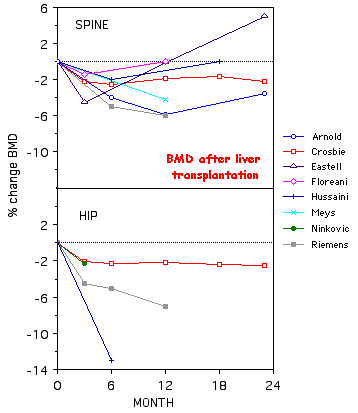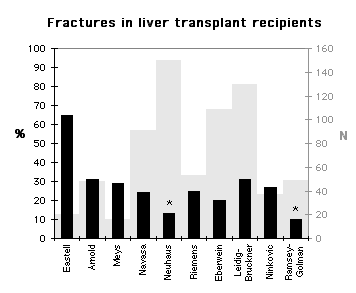| FACTOR | BONE EFFECT |
|---|---|
| Bilirubin excess | low bone formation |
| low vitamin D hydroxylation | Osteomalacia |
| Malnutrition | low bone formation |
| Acidosis | high bone resorption |
| Hypogonadism | high bone resorption |
Patients with end-stage liver failure, like those with renal failure, have multi-factorial metabolic bone disease. Serum from patients with cirrhosis inhibits osteoblast function; one study shows that bilirubin is responsible for much of the inhibition. Other metabolites that accumulate in cirrhosis may also be detrimental to osteoblast vigor.
The liver metabolizes vitamin D, and in some cases patients may develop osteomalacia due to deficiency of 25-OH-vitamin D. This is generally seen only in severe cases of hepatic failure.
Poor nutrition, inactivity, and use of corticosteroids also contribute to bone loss in these patients. Estrogen deficiency is not necessarily seen with liver failure, but may result from general ill health. Most physicians are reluctant to prescribe estrogen to these patients, because it may, in some cases, have hepatic toxicity. Transdermal estrogen does not have a first-pass through the liver and may be safer in this population.
 Each line on the graph is data from a different study.
Each line on the graph is data from a different study.
 The grey background shows number of patients in each study, the black bars are the fracture rates.
The grey background shows number of patients in each study, the black bars are the fracture rates.
Markers Bone biopsies Other complications Treatment
In an observational study of subjects who were 6 months post transplant, fluoride increased BMD by 25% in spine and 19% in hip, calcitriol 13% spine and 10% hip.
In a study of intravenous pamidronate every 3 months, 13 patients did not have develop symptomatic fractures. However, there was no control group.
Argao, E. A.(1994). Effect of orthotopic liver transplantation on bone mineral content and serum vitamin D metabolites in infants and children with chronic cholestasis. Hepatology 20(3): 598-603.
Arnold, J. C.(1992). Bone disease after liver transplantation. Transplant Proc 24(6): 2709-10.
Eastell(1991). Rates of vertebral bone loss before and after liver transplantation in women with primary biliary cirrhosis. Hepatology 14: 296-300.
Crosbie, O. M.(1999). Predicting bone loss following orthotopic liver transplantation. Gut 44(3): 430-434.
Floreani, A.(1998). Bone metabolism in orthotopic liver transplantation: a prospective study. Liver Transpl Surg 4(4): 311-9.
Haagsma(1988). Bone disease after orthotopic liver transplantation. J Hepatol 6: 94-100.
Hawkins, F. G.(1994). Bone loss and turnover in patients with liver transplantation. Hepatogastroenterology 41(2): 158-61.
Hay, J. E.(1993). Bone disease in liver transplant recipients. Gastroenterol Clin North Am 22(2): 337-49.
Hussaini, S. H.(1999). Regional bone mineral density after orthotopic liver transplantation. European Journal of Gastroenterology & Hepatology 11(2): 157-163.
Lopez, M. B.(1992). Effect of liver transplantation and immunosuppressive treatment on bone mineral density. Transplant Proc 24(6): 3044-6.
Losowsky, M. S.(1996). Bone disease after liver transplantation. Gut 39(4): 505-7.
McDonald, J. A.(1991). Bone loss after liver transplantation. Hepatology 14(4 Pt 1): 613-9.
Meys, E.(1994). Bone loss after orthotopic liver transplantation. Am J Med 97(5): 445-50.
Monegal, A.(1997). Osteoporosis and bone mineral metabolism disorders in cirrhotic patients referred for orthotopic liver transplantation. Calcif Tissue Int 60(2): 148-54.
Neuhaus, R.(1995). Treatment of osteoporosis after liver transplantation. Transplant Proc 27(1): 1226-7.
Reeves, H. L.(1998). Intravenous bisphosphonate prevents symptomatic osteoporotic vertebral collapse in patients after liver transplantation. Liver Transpl Surg 4(5): 404-9.
Riemens, S. C.(1996). Bone loss after liver transplantation is not prevented by cyclical etidronate, calcium and alphacalcidol. The Liver Transplant Group, Groningen. Osteoporos Int 6(3): 213-8.
Valero, M. A.(1995). Calcitonin and bisphosphonates treatment in bone loss after liver transplantation. Calcif Tissue Int 57(1): 15-9.
Vedi, S.(1999). Mechanism of bone loss after liver transplantation: A histomorphometric analysis. Journal of Bone and Mineral Research 14(2): 281-287.
Osteocalcin decreases the first couple of months after transplantation, then increases to values higher than normal. The high levels are found consistently.
Women with primary biliary cirrhosis have low osteocalcin, which increases with cyclosporine therapy even without a transplant.
Some patients have low levels of 25 or 1,25 vitamin D, but these are not characteristically decreased.
Post-transplant biopsies show increased bone formation rates; other abnormaliies are not significant. However, patients with primary biliary cirrhosis show low bone formation before transplant and variable rates after transplantation.
AVN was seen in 8% in one series. Most studies have not reported this complication but have not followed patients longer than two years
In one study etidronate or calcitonin was given to subjects with low bone density, who were 1 to 7 years post transplant. Spine BMD increased 6 to 8% with either treatment.
Table of literature review References
Abdelhadi, M.(1995). Bone mineral status in end-stage liver disease and the effect of liver transplantation. Scand J Gastroenterol 30(12): 1210-5.
/__ BACK to Transplant bone disease | FORWARD to Heart transplant
__\